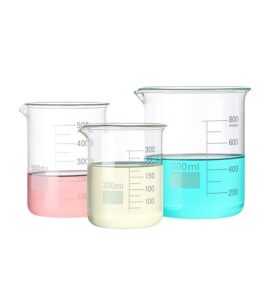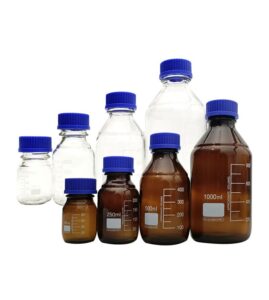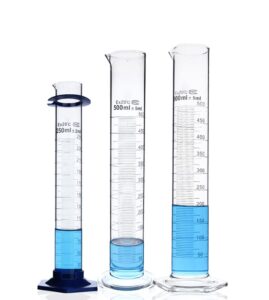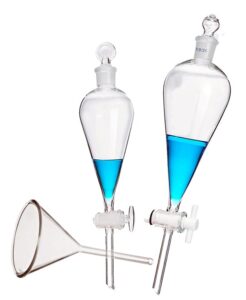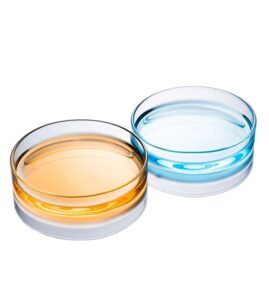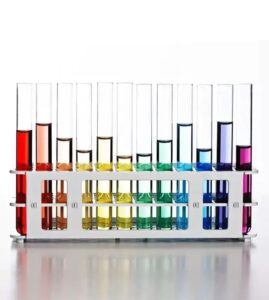Have you ever wondered how scientists ensure their glassware is impeccably clean? Or what magical concoctions they use to remove stubborn stains and residues from their laboratory equipment? Well, the answer lies in the secret formulas of various wash solutions meticulously designed for cleaning laboratory glassware.
The cleanliness of laboratory glassware is not just about visual tidiness. It’s a critical factor that can influence the accuracy and reliability of experimental results. Impurities or residues can cause cross-contamination, leading to skewed data or false interpretations.
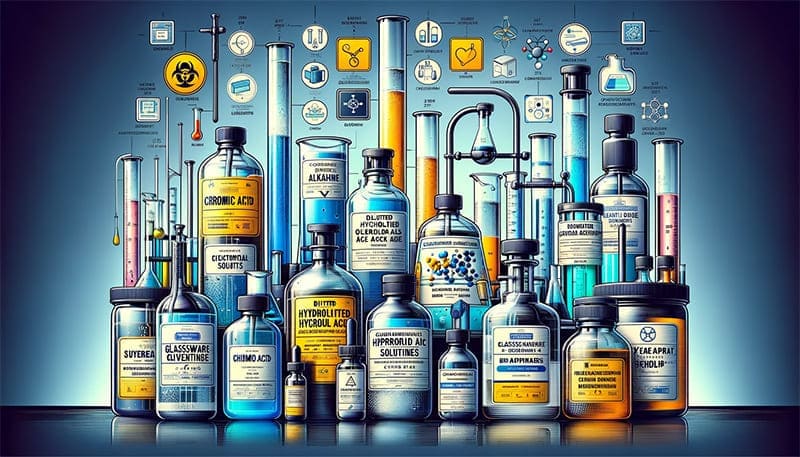
What Are the Main Types of Glassware Cleaning Solutions?
In laboratories, different types of wash solutions are employed, each tailored for specific types of contamination. These solutions range from simple detergents to more complex mixtures like chromic acid solutions.
Different Types of Wash Solutions for Laboratory Glassware
- Chromic Acid Wash Solution: This potent solution is often used for removing organic residues. However, it’s highly corrosive and must be handled with care.
- Diluted Hydrochloric Acid: Ideal for cleaning inorganic materials, this solution is effective but needs to be used cautiously due to its acidic nature.
- Alkaline Solutions: These are generally used for removing oils and some organic substances.
- Alkaline Ethanol Wash Solution: A mixture of NaOH and ethanol, this solution is particularly good for cleaning greases, tars, and resins.
- Alkaline Potassium Permanganate Solution: Effective for oily and organic stains, this solution leaves a brown residue of manganese dioxide, which can be cleaned using hydrochloric or oxalic acid.
- Sodium Phosphate Solution: This is used for cleaning carbon residues and requires soaking and scrubbing.
- Iodine-Potassium Iodide Solution: Particularly effective for cleaning silver nitrate stains.
- Organic Solvents: Solvents like benzene, ether, acetone, ethanol, and dichloromethane are used for dissolving and washing away certain organic compounds.
Preparation and Usage of Laboratory Glassware Cleaning Solutions
This is a comprehensive guide to preparing various cleaning solutions commonly used in laboratories for cleaning glassware:
- Chromic Acid Cleaning Solution
- Preparation: Dissolve 20 g of finely ground industrial-grade K2Cr2O7 in 40 ml of water, heat to dissolve. After cooling, slowly add 360 ml of concentrated sulfuric acid to the solution. Once cooled, transfer it to a bottle with a glass stopper.
- Usage: Useful for general oil stains; clean by rinsing with a small amount of solution or soaking overnight.
- Caution: Highly corrosive; avoid skin and clothing contact. Recycle after use. Store in a tightly sealed bottle to prevent water absorption and ineffectiveness. Discard when the solution turns green after treatment.
- Industrial Hydrochloric Acid
- Preparation: Mix hydrochloric acid and water in a 1:1 volume ratio.
- Usage: Effective for cleaning basic stains and most inorganic materials.
- Caution: The used solution can be recycled.
- Alkaline Cleaning Solution
- Preparation: 10% sodium hydroxide (NaOH) solution in water.
- Usage: Useful for cleaning oil stains and certain organic substances.
- Caution: Store the solution in a bottle with a plastic or rubber stopper.
- Alkaline Ethanol Cleaning Solution
- Preparation: Dissolve 60 g of NaOH in 80 ml of water, then add 95% ethanol to make up to 500 ml (proportions can be increased for larger quantities).
- Usage: Cleans grease, tar, resin, etc.
- Caution: Use a rubber stopper for the storage bottle. The solution can lose effectiveness over time; it’s volatile and flammable.
- Alkaline Potassium Permanganate Cleaning Solution
- Preparation: Dissolve 4 g of potassium permanganate in a small amount of water, add 10 g of sodium hydroxide, and then add water up to 100 ml (increase proportionally for larger quantities).
- Usage: Effective for oil stains and organic materials.
- Caution: After cleaning, brown MnO2 may deposit on previously stained areas, which can be removed with hydrochloric or oxalic acid.
- Sodium Phosphate Cleaning Solution
- Preparation: Dissolve 57 g of sodium phosphate and 28.5 g of sodium oleate in 470 ml of water (increase proportionally for larger quantities).
- Usage: Useful for cleaning carbon residues.
- Caution: Soak for several minutes before rinsing.
- Iodine-Potassium Iodide Cleaning Solution
- Preparation: Grind 1 g of iodine with 2 g of potassium iodide, dissolve in a small amount of water, then add water up to 10 ml (increase proportionally for larger quantities).
- Usage: Effective for cleaning brown residues of silver nitrate.
- Caution: Soak for a few minutes before washing.
- Common Organic Solvents
- Preparation: Use solvents like benzene, ether, acetone, ethanol, dichloroethane, chloroform as needed (increase proportionally for larger quantities).
- Usage: Useful for removing small amounts of organic substances that are difficult to clean by general methods.
- Caution: Be aware of toxicity and flammability; used solvents can be recycled through distillation for reuse.
These laboratory glassware cleaning solutions, tailored for specific contaminants, are crucial for maintaining the integrity and longevity of lab equipment. Safe handling and proper usage ensure effective cleaning and accurate experimental results. Remember to responsibly dispose of or recycle these chemicals, upholding safety and environmental standards.
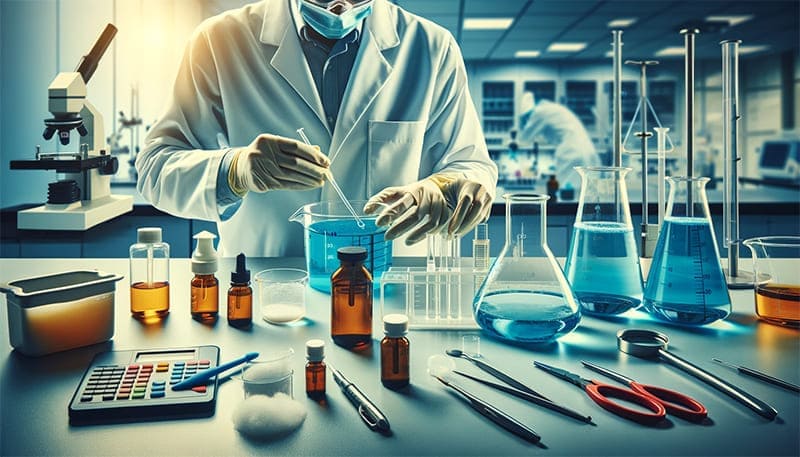
How Are These Solutions Prepared and Used?
The preparation and use of laboratory wash solutions involve meticulous processes and strict safety measures. Let’s delve into a more detailed examination of these aspects:
1. Preparations Before Use
Gathering Materials: Before preparing any solution, ensure you have all necessary materials, including chemicals, measuring instruments, and containers.
Safety Equipment: Essential safety equipment includes gloves, goggles, and lab coats. Ensure they are in good condition and appropriate for the chemicals being handled.
Ventilation: Work in a well-ventilated area, preferably under a fume hood, to avoid inhaling fumes.
Reading Protocols: Thoroughly review the preparation protocols for each solution, noting specific measurements and mixing orders.
Labeling and Documentation: Clearly label all solutions with their contents and the date of preparation. Maintain records of what solutions were prepared, by whom, and when.
2. How to Use the Solutions
Measuring and Mixing: Follow the specified ratios and procedures for each solution. For example, when preparing a chromic acid wash solution, dissolve potassium dichromate in water before slowly adding concentrated sulfuric acid.
Application: Apply the solution to the glassware using the recommended method, such as soaking, scrubbing, or rinsing.
Timing: Adhere to suggested contact times; some solutions may require soaking overnight, while others work within minutes.
3. Safety Considerations During Use
Handling Chemicals: Handle all chemicals with care, avoiding direct skin contact and inhalation of fumes.
Avoiding Contamination: Use separate containers and utensils for different solutions to prevent cross-contamination.
Spillage Response: In case of a spill, follow the lab’s spill response protocol, using neutralizers and cleaning up materials safely.
4. Emergency Measures
First Aid: Familiarize yourself with first-aid procedures for chemical exposure, such as flushing the affected area with water in case of skin contact or seeking immediate medical attention for more severe exposures.
Spill Management: Keep spill containment kits accessible. In the event of a spill, alert others, ventilate the area, and contain and clean the spill using appropriate materials.
Fire Safety: Be aware of the fire risks associated with flammable solutions. Keep a fire extinguisher nearby and know how to use it.
Emergency Contacts: Have a list of emergency contacts, including local emergency services and poison control centers, readily available.
The preparation and use of laboratory wash solutions require a combination of careful planning, precise execution, and adherence to safety protocols. By meticulously following these guidelines, laboratory personnel can ensure their safety and the integrity of their work.
Recycling and Disposal of Laboratory Glassware Cleaning Solutions
After using the aforementioned cleaning solutions in the laboratory, proper disposal or recycling is essential to maintain environmental safety and laboratory hygiene. Here are guidelines for handling each type of solution post-cleaning:
1. Chromic Acid Cleaning Solution
Recycling: Chromic acid solutions can be reused multiple times. Store the used solution in a designated container. When the solution turns green, indicating the chromium is in its trivalent state, it’s time to dispose of it.
Disposal: Due to its toxicity and environmental impact, chromic acid waste should be treated as hazardous waste. Follow your institution’s protocols for hazardous waste disposal, often involving a chemical waste disposal company.
2. Industrial Hydrochloric Acid
Recycling: Hydrochloric acid solutions can often be reused for cleaning. Store used solution in a separate container for future use.
Disposal: Diluted hydrochloric acid can be neutralized with a base, like sodium bicarbonate, until it reaches a neutral pH. Then, it can be disposed of down the drain with copious amounts of water, following local wastewater regulations.
3. Alkaline Cleaning Solution
Recycling: Alkaline solutions, especially those used for light cleaning, can be reused. Monitor the solution for effectiveness and contamination.
Disposal: Neutralize the solution with an acid, such as hydrochloric acid, until it reaches a neutral pH. Dispose of the neutralized solution as per local environmental regulations.
4. Alkaline Ethanol Cleaning Solution
Recycling: This solution can degrade over time. However, if stored properly, it can be reused until it shows signs of ineffectiveness.
Disposal: Due to its flammability, dispose of ethanol-based solutions according to flammable waste protocols. This often involves using designated flammable waste containers and disposal services.
5. Alkaline Potassium Permanganate Cleaning Solution
Recycling: This solution is typically not reused due to its strong oxidizing properties and the potential for manganese dioxide buildup.
Disposal: Neutralize with a reducing agent, such as sodium bisulfite, before disposal. Once neutralized, it can be safely disposed of according to local regulations.
6. Sodium Phosphate Cleaning Solution
Recycling: This solution can be reused for cleaning similar types of residues. Store in a marked container.
Disposal: Sodium phosphate solutions are generally non-toxic and can be disposed of down the drain with plenty of water, following local wastewater guidelines.
7. Iodine-Potassium Iodide Cleaning Solution
Recycling: Due to its specific use for silver nitrate residues, this solution is usually not reused.
Disposal: Treat as chemical waste. It should be collected in a designated container and disposed of through a chemical waste disposal process.
8. Common Organic Solvents
Recycling: Organic solvents can often be distilled and reused. Set up a solvent recycling protocol in your lab if feasible.
Disposal: Used solvents should be collected in designated flammable waste containers. Dispose of them through appropriate hazardous waste disposal channels.
In all cases, it’s crucial to follow the specific environmental and safety regulations of your institution and local government. Proper labeling, storage, and disposal not only ensure safety but also minimize environmental impact. Remember, responsible chemical management is a cornerstone of sustainable laboratory practices.
Storage Methods and Precautions for Laboratory Glassware Cleaning Solutions
Proper storage and handling of cleaning solutions are critical in ensuring their effectiveness and safety in the laboratory. Here’s a guide on how to store the aforementioned glassware cleaning solutions and the precautions to be taken:
1. Chromic Acid Cleaning Solution
Storage: Store in a glass bottle with a tight-fitting glass stopper. Avoid using metal caps or containers as chromic acid is highly corrosive.
Precautions: Store in a cool, dry place away from organic materials and flammable substances. Clearly label the bottle as hazardous.
2. Industrial Hydrochloric Acid
Storage: Keep in a corrosion-resistant container, preferably glass, with a tight-sealing cap.
Precautions: Store away from bases, oxidizing agents, and metals. Ensure it’s stored in a well-ventilated area and labeled correctly.
3. Alkaline Cleaning Solution
Storage: Use a plastic or rubber-stoppered bottle for storage. Glass may be degraded by the alkalinity over time.
Precautions: Store in a cool place. Keep away from acids and flammable materials. Ensure it’s clearly labeled.
4. Alkaline Ethanol Cleaning Solution
Storage: Store in a container with a rubber stopper. Glass containers are preferable.
Precautions: Since it’s volatile and flammable, store away from heat sources, sparks, and open flames. Ensure the storage area is well-ventilated.
5. Alkaline Potassium Permanganate Cleaning Solution
Storage: Use a glass container with a non-metallic cap or stopper.
Precautions: Store in a cool, dark place as it is sensitive to light. Keep away from organic materials and flammable substances.
6. Sodium Phosphate Cleaning Solution
Storage: Store in a glass container with a suitable stopper.
Precautions: This solution is generally safe, but it should be stored in a cool, dry place away from food and drink.
7. Iodine-Potassium Iodide Cleaning Solution
Storage: A brown glass bottle is ideal for storage to protect from light, with a tight cap to prevent evaporation.
Precautions: Store in a cool, dark place. Avoid contact with metals and strong reducing agents.
8. Common Organic Solvents
Storage: Store in a fire-proof cabinet designed for flammable liquids. Use containers that are compatible with the solvent material.
Precautions: Keep away from heat, sparks, and open flames. Store in a well-ventilated area and ensure all containers are clearly labeled.
General Storage Tips
- Labeling: All containers should be clearly labeled with the contents and date of preparation. Include hazard symbols as necessary.
- Segregation: Store different types of chemicals separately according to their compatibility. For example, acids should be stored separately from bases.
- Inspection: Regularly inspect storage areas for leaks, corrosion, or any signs of degradation.
- Access Control: Restrict access to the storage areas to trained personnel only.
By adhering to these storage methods and precautions, you can ensure the safe and effective use of cleaning solutions in your laboratory, while also maintaining a safe working environment.
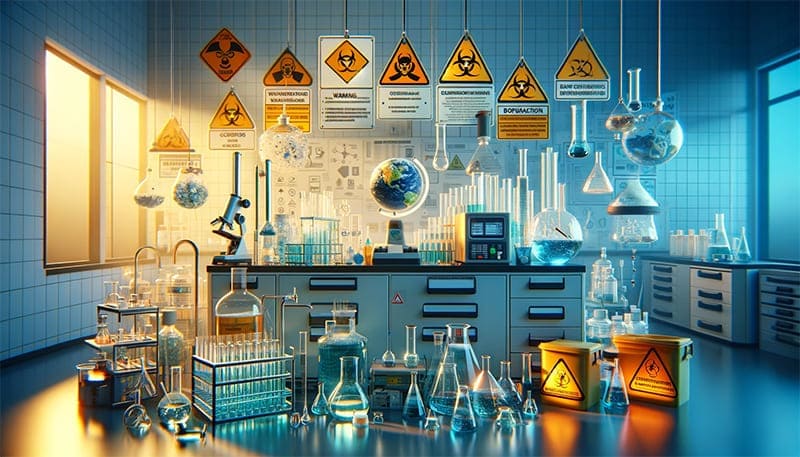
What Are the Safety Considerations and Environmental Impacts?
The disposal of these cleaning solutions is a significant concern. Chromic acid, for instance, contains hexavalent chromium, a known carcinogen, and must be disposed of as hazardous waste. Similarly, organic solvents require proper waste management due to their flammable and toxic nature.
It’s essential to adhere to environmental regulations and safety protocols when disposing of these chemicals. In some cases, solutions like chromic acid are being phased out in favor of more environmentally friendly alternatives.
The Intricacies of Mixing and Using Wash Solutions
When mixing these solutions, precision is key. The exact proportions of chemicals and water ensure effectiveness while minimizing risks. For instance, in making an alkaline ethanol wash solution, the ratio of NaOH, water, and ethanol must be carefully measured. This precision ensures that the solution effectively cleans without causing damage to the glassware or posing undue risk to the user.
Using these solutions typically involves soaking the glassware, sometimes overnight, especially for stubborn residues. After soaking, thorough rinsing with distilled water is crucial to remove all traces of the cleaning solution. Incomplete rinsing can lead to contamination of subsequent experiments.
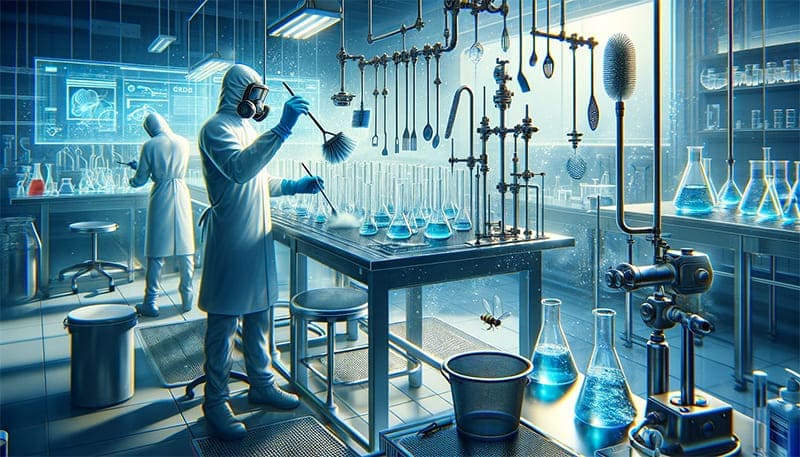
The Role of Mechanical Cleaning
In addition to chemical solutions, mechanical cleaning methods like scrubbing with brushes are often necessary, particularly for removing precipitates or residues adhered to the glass surfaces. It’s important to use brushes that are soft enough not to scratch the glass but firm enough to remove residues effectively.
Alternatives to Traditional Cleaning Solutions
Given the environmental and safety concerns associated with some traditional cleaning solutions, there’s a growing interest in greener alternatives. For example, enzymatic cleaners and biodegradable detergents are gaining popularity. These alternatives are less hazardous and more environmentally friendly while still providing effective cleaning.
Tips for Maintaining Glassware Cleanliness
- Immediate Cleaning: It’s easier to clean glassware immediately after use, as residues are less likely to harden or react with the glass.
- Regular Inspection: Regularly inspect glassware for damage or residues missed during cleaning.
- Proper Storage: Store glassware in a clean, dust-free environment to prevent contamination.
- Labeling: Label glassware used for specific chemicals to prevent cross-contamination.
The Importance of Training and Protocols
Proper training in handling and preparing these cleaning solutions is crucial. Laboratory personnel must be aware of the risks and safety procedures associated with each type of wash solution. Additionally, labs should have standard operating procedures (SOPs) for cleaning glassware, ensuring consistency and safety across all experiments.
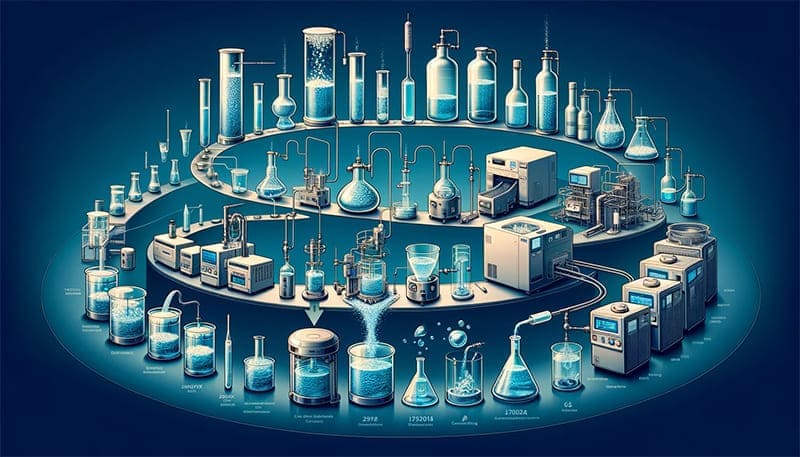
The Evolution of Glassware Cleaning Techniques
As science progresses, so do the methods and materials used in laboratories. This evolution is not just limited to experimental techniques but extends to the mundane yet crucial task of cleaning glassware. With advancements in chemistry and a better understanding of environmental impacts, newer and safer methods are continually being developed.
Ultrasonic Cleaning: A Modern Approach
Ultrasonic cleaners have emerged as a powerful tool in the arsenal of laboratory glassware cleaning techniques. By using high-frequency sound waves to agitate a liquid, these cleaners effectively remove dirt and residue from glassware. This method is particularly useful for delicate or intricate glassware that might be damaged by manual scrubbing.
The Role of Automation in Glassware Cleaning
Automated glassware washing systems are becoming increasingly common in larger laboratories. These systems not only save time but also ensure a consistent and thorough cleaning process. They are especially useful for standardized procedures where contamination control is critical.
Best Practices for Handling Delicate Glassware
Delicate glassware requires special attention. It’s important to handle these items with care to avoid breakage. When cleaning delicate glassware, gentle detergents and soft brushes are recommended. Sometimes, simply rinsing with a suitable solvent, followed by distilled water, is sufficient.
The Use of Distilled Water in Rinsing
The final rinse of glassware, regardless of the cleaning method used, should ideally be done with distilled or deionized water. This practice ensures that no residues from tap water, such as minerals or organic compounds, are left on the glassware.

The Future of Glassware Cleaning: Sustainability and Efficiency
As we move towards a more sustainable future, the focus on eco-friendly cleaning solutions and practices in laboratories is increasing. Researchers and manufacturers are working on developing cleaning agents that are effective yet have a minimal environmental footprint. This shift not only reflects the scientific community’s responsibility towards the environment but also aligns with the global trend of embracing sustainable practices.
Conclusion
As we navigate the intricate world of laboratory maintenance, the mastery of glassware cleaning stands as a cornerstone of scientific precision and safety. Embracing the knowledge of proper cleaning techniques is not just about maintaining cleanliness; it’s about committing to the highest standards of scientific integrity. Let’s continue to refine our methods, adopt sustainable practices, and uphold the meticulousness that science demands. Remember, the clarity of our glassware reflects the clarity of our scientific endeavors. Let us all strive for that pristine transparency in our quest for discovery and knowledge.


